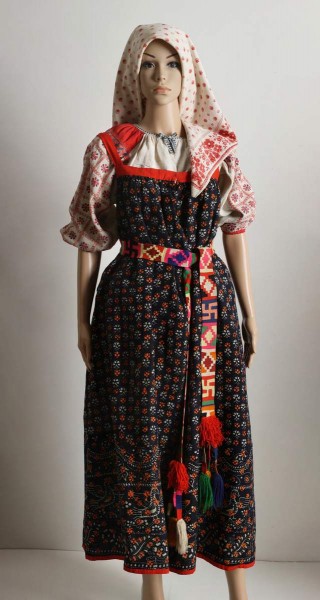Peasant Woman’s Festive Costume
Север. 19th century
- Cube printed fabric, red calico, linen, cotton, double-sided stitching
- Н-1879; В-790
Sarafan
Canvas, red calico, cube printed fabric
Shirt
Canvas, double-sided stitching
The art of printing, known far back in ancient times, was one of the most popular folk methods of decorating textiles. In the 16th and 17th centuries there were workshops and stalls in many Russian towns where cloth was printed and sold. But as hand oil printing, which did not allow for a great range of colors, was gradually superseded by factory-made cloth, vat-dyed canvas remained part of the peasant costume right up until the 1910s.
Vat-dyed prints were particularly common in the Russian North — blue sarafans with yellow and white lace decorations, adorned with orange oil stamps — were a perfect match for the bright red calico and red-and-white patterns embroidered on shirts.
It was not only the northern craftsmen who were famous for their vat dyeing and printing techniques; it was also common in many other Russian regions. In time, under the influence of city fashions, vat dyeing disappears from the countryside too, replaced by factory prints. The technique of vat dyeing was known in China at the beginning of the second millennium. There were two methods: in one case the pattern was drawn on the undyed cloth with special resistant mixture, the cloth was immersed in a vat of indigo dye. When dyeing was complete the mixture was wiped off and a pattern was left on a blue background. In the second case the pattern was drawn into dyed cloth with a dye removing substance.

